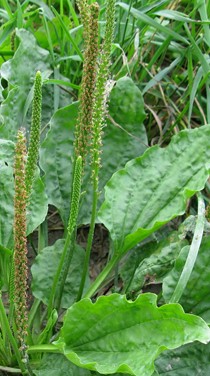 Common plantain,(Plantago major) is an herbaceous perennial native to Europe and northern and central Asia but naturalized in the US beginning in the time of the Puritans. It thrives in disturbed areas and can be found along roadsides, and in fields and lawns. Comon Plantain belongs to the Plantaginaceae family which also includes the garden plants Angelonia, Penstemon, and Chelone. Plants have a rosette of thick leaves, each from 2 to 8 inches long and 2 to 3.5 inches wide and with five to nine longitudinal veins. From the beginning of summer through fall, tiny purplish-green flowers are carried in dense slender spikes six to eighteen inches tall. Each plant can produce up to 20,000 seeds. Common plantain likes average, well-drained soil in sun or part shade.
Common plantain,(Plantago major) is an herbaceous perennial native to Europe and northern and central Asia but naturalized in the US beginning in the time of the Puritans. It thrives in disturbed areas and can be found along roadsides, and in fields and lawns. Comon Plantain belongs to the Plantaginaceae family which also includes the garden plants Angelonia, Penstemon, and Chelone. Plants have a rosette of thick leaves, each from 2 to 8 inches long and 2 to 3.5 inches wide and with five to nine longitudinal veins. From the beginning of summer through fall, tiny purplish-green flowers are carried in dense slender spikes six to eighteen inches tall. Each plant can produce up to 20,000 seeds. Common plantain likes average, well-drained soil in sun or part shade.
Shakespeare mentions plantain in four plays.
1. In Loves Labour’s Lost (act iii, sc. 1, 76) the fool, Costard, and the page, Moth converse;
Costard:
O sir, Plantain, a plain Plantain! No
L’envoy, no l’envoy; no salve, sir, but a Plantain.
Moth:
By saying that costard was broken in a shin. Then call’ed you for the l’envoy.
Costard:
True! And I for a Plantain,
2. Romeo (Romeo and Juliet act 1 sc 2, 5) share a similar exchange with Benvolio, Romeo’s cousin and friend;
Romeo:
Your Plantain leaf is excellent for that.
Benvolio:
For what, I pray thee?
Romeo:
For your broken shin
3. Trolius, prince of Troy declares his fidelity to his beloved Cressida (Trolius and Cressida act iii, sc. 2, 184 );
As true as steel, as Plantage to the moon.
4. Palamon says to his cousin and friend Arcite (Two Noble Kinsmen act 1, sc. 2, 65);
These poor slight sores
Neede not a Plantin.
Plantian has been valued as a medicinal herbs at least since ancient Roman times and Pliny mentioned that it cured madness in dogs. The ancient Saxons who called it weybroad, considered it one of the nine sacred herbs. For early Christians it symbolized the well-trodden path of the multitude who sought Christ. Even today herbals suggest it as a treatment for such problems as bee stings and the itching from poison ivy.